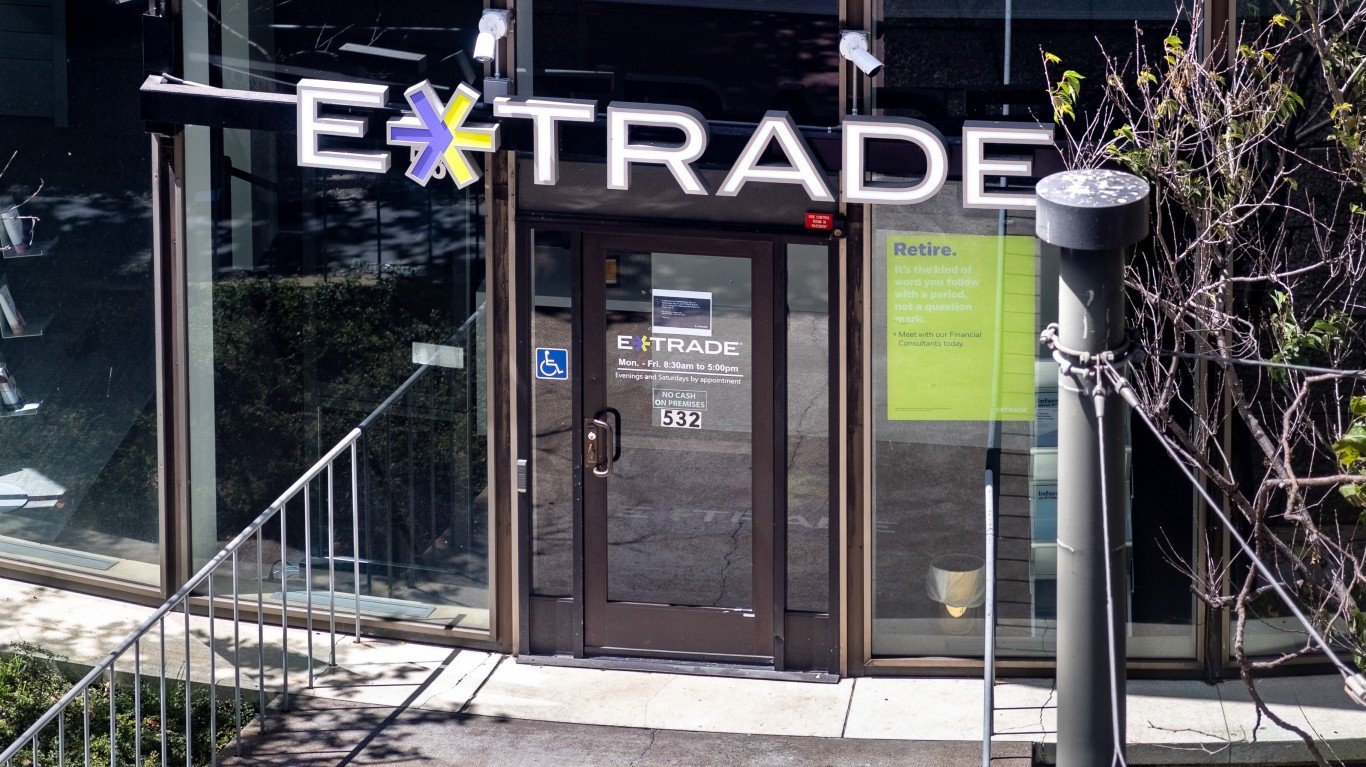

U.S. equity markets got off to a slow start this week, with the S&P 500 and the Dow Jones industrials both closing essentially flat Monday and the Nasdaq up by about 0.2%. While the country’s big banks are hardly a bellwether for the economy, how they performed in the third quarter and how they think they will perform in the fourth quarter will trickle down through other market sectors.
That trickle begins as a flood Thursday morning, when five of the nation’s largest banks report quarterly earnings. Here’s a look at what analysts are expecting.
[in-text-ad]
Bank of America
Bank of America Corp. (NYSE: BAC) is the nation’s second-largest bank by market cap, and it has enjoyed a share price boost of 76% over the past 12 months. Revenues in the first half of the year got a boost when the Federal Reserve allowed it and the other big banks to reduce their loan loss provisions. Some of that cash was used to pay dividends, but some was also used to meet rising expenses. Higher pay to keep and attract staff and investments in technology added to operating costs, and the big question is whether revenues will have been able to keep pace with those higher costs.
Analysts are bullish on BofA, with 16 of 26 putting a Buy or Strong Buy rating on the shares. Another eight rate the stock at Hold. At a recent price of around $43.80, the implied gain based on a median price target of $45 is about 2.7%. At the high price target of $52, the implied upside is 18.7%.
Third-quarter revenue is forecast at $21.6 billion, which would be up by less than 1% sequentially and 5.6% higher year over year. Adjusted earnings per share (EPS) are expected to come in at $0.70, or a drop of 32% sequentially but up 37.3% year over year. For the full fiscal year, analysts currently forecast EPS of $3.20, up 71.3%, on revenue of $87.56 billion, about 1.8% higher.
BofA’s stock trades at 13.8 times expected 2021 EPS, 14.6 times estimated 2022 earnings and 12.9 times estimated 2023 earnings. The stock’s 52-week trading range is $23.12 to $44.87. It pays an annual dividend of $0.84 (yield of 1.89%).
Citigroup
The fifth-largest U.S. bank by market cap, Citigroup Inc. (NYSE: C) stock had climbed to a 12-month gain of around 83% in early June. Since then the stock has dropped more than 9%, primarily on concerns that third-quarter revenues would slip both sequentially and year over year. Citi was able to squeeze out some costs in the second quarter, but that came after more than $20 billion in costs reported in the first quarter. Along with JPMorgan and Morgan Stanley, Citi could report negative operating leverage this year.
[in-text-ad]
Analysts remain bullish on the stock, with 18 of 25 putting a Buy or Strong Buy rating on the shares and the other seven rating the stock at Hold. At a price of around $71.50, the upside potential based on a median price target of $84 is 17.5%. At the high price target of $112, the upside potential is 56.6%.
Third-quarter revenue is forecast at $17.02 billion, down about 2.6% sequentially and 1.6% year over year. Adjusted EPS are forecast at $1.79, or 37% lower sequentially but up about 28% year over year. For fiscal 2021, analysts currently forecast EPS of $10.00, up 105%, on revenue of $70.62 billion, down about 5%.
The stock trades at 7.2 times expected 2021 EPS, 9.1 times estimated 2022 earnings and 8.1 times estimated 2023 earnings. The stock’s 52-week range is $40.49 to $80.29, and Citi pays an annual dividend of $2.04 (yield of 2.85%).
Morgan Stanley
Morgan Stanley (NYSE: MS) is the fourth-largest U.S. bank by market cap. As is the case with JPMorgan Chase (we previewed those earnings earlier), analysts will be paying close attention to Morgan Stanley’s operating leverage, the ratio between the 12-month change in expenses and revenues. Analysts expect both banks to report negative operating leverage in the third quarter. Morgan Stanley’s share price has more than doubled over the past 12 months, even though it has come down slightly from a 52-week high posted in late August.
Sentiment remains bullish on the stock, with 19 of 28 brokerages assigning the shares a Buy or Strong Buy rating. Another eight recommend holding the stock. At a price of around $97.90, the upside potential based on a median price target of $108 is 10.3%. At the high target of $125, the upside potential is 27.8%.
The consensus estimate for third-quarter revenue is $13.95 billion, down about 5.5% sequentially and up nearly 20% year over year. Adjusted EPS are forecast at $1.68, down 11% sequentially and up 5.6% year over year. For full fiscal 2021, analysts are looking for revenue of $58.21 billion, which would be nearly 21% higher, and EPS of $7.51, up more than 14%.
Morgan Stanley stock trades at 13.0 times expected 2021 EPS, 13.3 times estimated 2022 earnings and 11.7mtimes estimated 2023 earnings. The stock’s 52-week range is $46.55 to $105.95, and the bank pays an annual dividend of $2.80 (yield of 2.8%).
US Bank
U.S. Bancorp (NYSE: USB) is the country’s largest regional bank (seventh-largest overall), and it operates more than 2,400 locations in the West and Midwest. The bank’s share price has jumped by more than 64% in the past 12 months, including a dip of 12% between mid-May and mid-June. Since then the stock has added about 15.6%.
[in-text-ad]
Last month the bank announced that it will acquire Mitsubishi UFJ Financial Group’s West Coast locations for $5.5 billion in cash and about 44 million shares of U.S. Bank stock. The acquisition adds more than a million retail customers in California, Oregon and Washington and around 190,000 small business customers. That announcement gave the shares their lift out of the doldrums.
Analysts are mixed on U.S. Bank, with 11 of 22 rating the stock at Hold and the rest rating the shares at Buy or Strong Buy. At a price of around $62, the upside potential based on a median price target of $64 is 3.2%. At the high target of $76, the upside potential is 22.5%.
The consensus third-quarter revenue estimate is $5.76 billion, up by less than 1% sequentially and down 3% year over year. Adjusted EPS are estimated to come in at $1.16, down 9.6% sequentially and down 17.2% year over year. Analysts are looking for full-year revenue of $22.73 billion, down 2.1%, and EPS of $4.32, down 13.9%.
The stock trades at 12.5 times expected 2021 EPS, 14.5 times estimated 2022 earnings and 11.9 times estimated 2023 earnings. The stock’s 52-week range is $36.57 to $63.00, and the high was posted Monday. U.S. Bank pays an annual dividend of $1.84 (yield of 2.95%).
Wells Fargo
Wells Fargo & Co. (NYSE: WFC) is the nation’s third-largest bank (as measured by market cap) and the one big bank with more than a handful of regulatory problems. Although some of the problems related to the bogus account scandal of several years ago are now gone, the bank is still operating under 10 consent orders. The most important is the asset cap imposed in 2018 that prohibits the bank from growing its balance sheet beyond about $1.95 trillion until it cleans up its act. That hasn’t prevented the bank’s share price from increasing by nearly 90% over the past 12 months.
Analysts are positive, if not enthusiastic, about Wells Fargo. Of 26 brokerages covering the bank, 13 have a Hold rating and the other 13 have a Buy or Strong Buy rating on the shares. At the price of around $47.30, the upside potential based on a median price target of $51.50 is about 8.9%. At the high price target of $60, the upside potential is about 26.8%.
Analysts are expecting third-quarter revenue to total $18.31 billion, down about 9.7% sequentially and about 2.9% year over year. Adjusted EPS are forecast at $0.94, down more than 31% sequentially but up nearly 29% year over year. For fiscal 2021, EPS are forecast to rise nearly 285% to $4.09 and revenue is expected to rise by 3.9% to $75.15 billion.
Wells Fargo stock trades at 11.7 times expected 2021 EPS, 13.3 times estimated 2022 earnings and 11.3 times estimated 2023 earnings. The stock’s 52-week range is $20.76 to $51.41, and Wells Fargo pays an annual dividend of $0.80 (yield of 1.67%).
Sponsored: Find a Qualified Financial Advisor
Finding a qualified financial advisor doesn’t have to be hard. SmartAsset’s free tool matches you with up to 3 fiduciary financial advisors in your area in 5 minutes. Each advisor has been vetted by SmartAsset and is held to a fiduciary standard to act in your best interests. If you’re ready to be matched with local advisors that can help you achieve your financial goals, get started now.
Thank you for reading! Have some feedback for us?
Contact the 24/7 Wall St. editorial team.
 24/7 Wall St.
24/7 Wall St. 24/7 Wall St.
24/7 Wall St.


